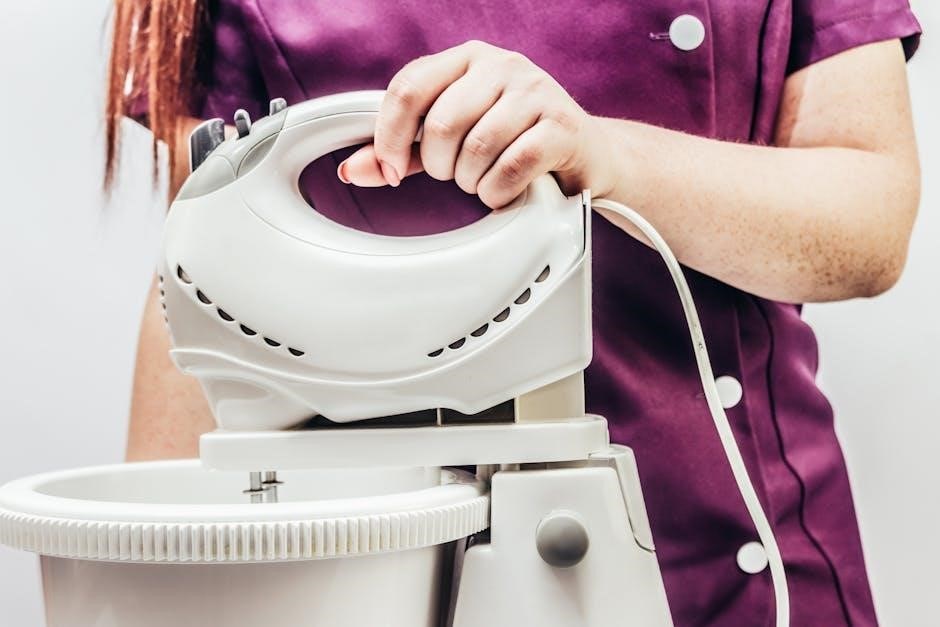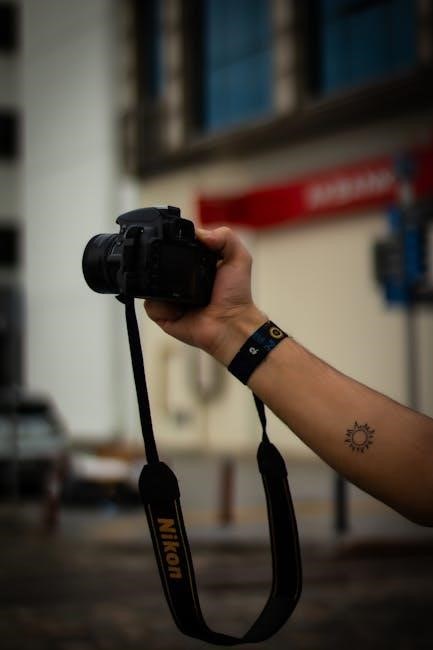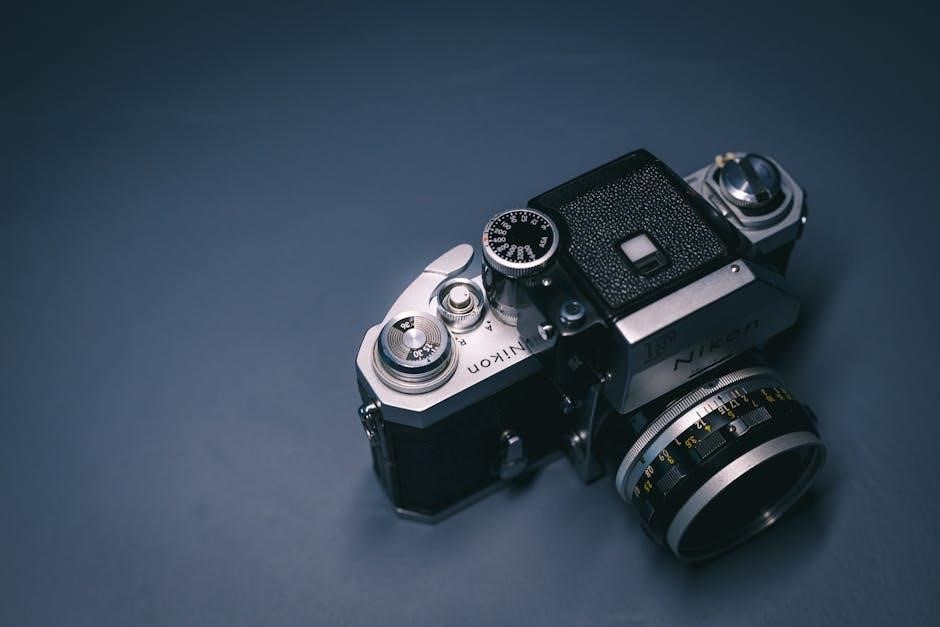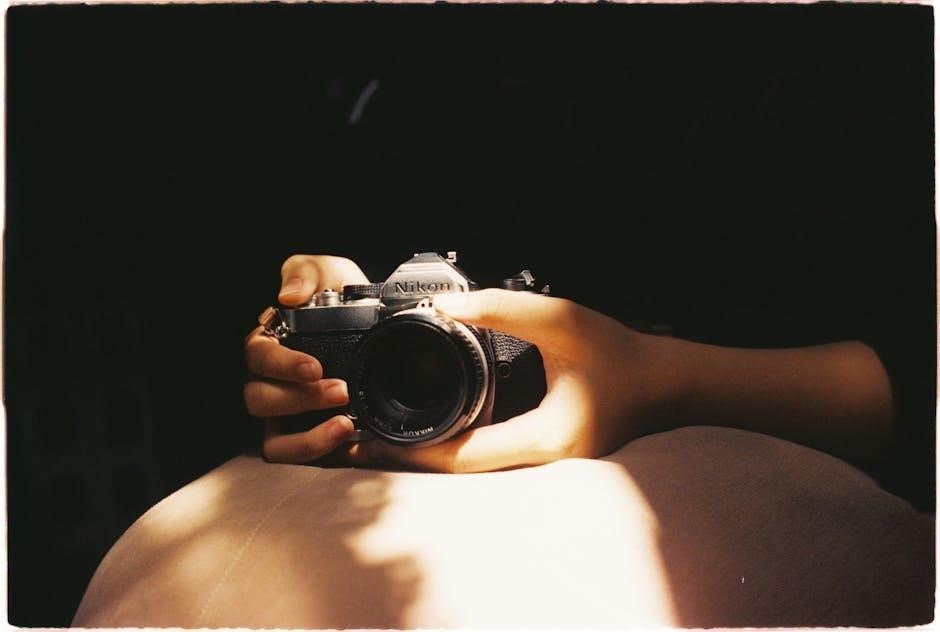The Nikon D810 instruction manual is a comprehensive guide to unlocking the camera’s full potential, detailing its advanced features and settings. Available for download from Nikon’s official website or third-party sources, it ensures users master the 36.3MP sensor, interchangeable lenses, and specialized modes. This manual is essential for both beginners and experienced photographers seeking to optimize their D810 experience.
Overview of the Nikon D810
The Nikon D810 is a high-performance DSLR camera featuring a 36.3-megapixel full-frame CMOS sensor, delivering exceptional image quality. Designed for versatility, it supports interchangeable lenses, making it ideal for various photography styles. Key advancements include an electronic first curtain shutter and a split-screen zoom display in Live View for precise focusing. The camera also introduces RAW S for smaller file sizes and enhanced bracketing options. With its robust SLR design and advanced features, the D810 caters to professionals and enthusiasts, offering superior control and creativity in capturing stunning images across diverse shooting conditions.
Importance of the Instruction Manual
The Nikon D810 instruction manual is crucial for maximizing the camera’s capabilities. It provides detailed explanations of advanced features like the electronic first curtain shutter and RAW image processing. Users can learn to navigate the custom settings menu, utilize focus shift shooting, and understand metering modes. The manual also covers troubleshooting tips, such as resolving white spots in long exposures. By following the guide, photographers can enhance their workflow, ensure optimal camera maintenance, and explore creative possibilities. It serves as an essential resource for both novices and experienced users aiming to master the D810’s sophisticated functions and settings.

Downloading the Nikon D810 Instruction Manual
Download the Nikon D810 manual from Nikon’s official website or via the Nikon Manual Viewer 2 app for easy access and convenience.
Official Sources for the Manual
The Nikon D810 instruction manual can be downloaded directly from Nikon’s official website. Visit the support section, navigate to the D810 product page, and locate the manual under downloads. The manual is typically available in multiple languages and formats, including PDF. Additionally, Nikon provides the Manual Viewer 2 app, which allows users to access the manual digitally. Ensure you only download from trusted sources to avoid unauthorized versions. For convenience, use the model number (D810) in your search to quickly find the correct document. Always verify authenticity to ensure you’re using the official, up-to-date version.
Third-Party Websites and Verification
While third-party websites may offer the Nikon D810 manual, verify their authenticity to avoid outdated or incorrect versions. Be cautious of unofficial sources, as they may provide incomplete or altered documents. Always cross-check the manual’s content with Nikon’s official website to ensure accuracy. For added safety, download from trusted sources like ManualsLib or ManualsOnline, which are known for reliable documentation. Avoid sites with suspicious links or excessive ads to prevent potential malware risks. Verify the manual’s publication date and version number to ensure it matches Nikon’s latest release. Prioritize official sources for the most accurate and up-to-date information.
Using the Nikon Manual Viewer 2 App
The Nikon Manual Viewer 2 app provides convenient digital access to the Nikon D810 instruction manual. Available for iOS and Android, this app allows users to download and view the manual offline, ensuring accessibility anytime. It features a user-friendly interface with search functionality, enabling quick navigation to specific topics. The app also supports zoom for detailed viewing and bookmarks for easy reference. Regular updates ensure the latest version of the manual is available. This tool is ideal for photographers who prefer digital convenience and need to reference the manual on the go. It enhances the learning and operational experience of the Nikon D810.

Key Features of the Nikon D810
The Nikon D810 boasts a 36.3MP full-frame sensor, delivering exceptional image quality. It offers interchangeable lenses, advanced autofocus, and robust weather-sealing for professional-grade performance and versatility.
36.3 Megapixel CMOS Sensor
The Nikon D810 features a 36.3-megapixel full-frame CMOS sensor, delivering exceptional image quality with outstanding resolution and dynamic range. This sensor captures intricate details, ensuring sharp and vibrant images even in challenging lighting conditions. The absence of an optical low-pass filter enhances sharpness further, making it ideal for professional photographers. The sensor’s high pixel count allows for large prints and precise cropping without compromising quality. Its excellent ISO range provides flexibility in low-light situations, while the ability to shoot in both FX and DX formats offers versatility for diverse shooting needs.
Interchangeable Lenses and Versatility
The Nikon D810 supports a wide range of interchangeable NIKKOR lenses, offering unparalleled versatility for photographers. With the F-mount system, users can choose from over 80 high-quality lenses, including wide-angle, telephoto, macro, and zoom options. This flexibility allows photographers to adapt to various shooting scenarios, from landscapes to portraits. The camera is compatible with both FX and DX-format lenses, providing options for different photography styles and budgets. The ability to swap lenses ensures the D810 can grow with the photographer’s needs, making it a versatile tool for professional and enthusiast photographers alike.
Electronic First Curtain Shutter
The Nikon D810 features an Electronic First Curtain Shutter, designed to reduce camera shake and noise during exposures. This mechanism uses an electronic signal to start the exposure, eliminating the noise of the first curtain in the mechanical shutter. Ideal for live view shooting, it minimizes vibrations, ensuring sharper images. The Electronic First Curtain Shutter is particularly useful in quiet environments or when photographing subjects sensitive to noise. It enhances image quality by reducing blur caused by mirror slap, making it beneficial for landscape, studio, and wildlife photography. This feature underscores the D810’s commitment to delivering precise and professional results.
Split Screen Zoom Display in Live View
The Nikon D810 offers a Split Screen Zoom Display in Live View, enabling precise focus comparisons. This feature divides the screen into two sections, allowing you to zoom in on two separate areas of the image at 100% magnification simultaneously. Ideal for landscape or studio photography, it ensures sharpness across the frame. Activate it by pressing the zoom button during Live View, then adjust focus independently in each section. This tool is invaluable for manual focusing, reducing the need for post-processing corrections. It streamlines your workflow, ensuring accuracy and confidence in your compositions.

Camera Specifications
The Nikon D810 features a 36.3MP full-frame CMOS sensor, ISO 64-12,800, 5fps continuous shooting, and full HD video recording capabilities, ensuring exceptional image quality and versatility.
Resolution and Sensor Details
The Nikon D810 is equipped with a 36.3-megapixel full-frame CMOS sensor, delivering exceptional image detail and clarity. Its FX-format sensor captures images at a maximum resolution of 7,360 × 4,912 pixels. The sensor’s design omits the optical low-pass filter, enhancing sharpness and reducing moiré. With a native ISO range of 64–12,800, the camera excels in low-light conditions while maintaining minimal noise. This combination ensures vibrant colors, precise tonal gradations, and a wide dynamic range, making it ideal for professional photography, including landscapes, portraits, and studio work.
SLR Camera Body Type
The Nikon D810 features a robust, weather-sealed magnesium alloy body, designed for durability and professional use. As a digital SLR (DSLR), it incorporates a mirror-and-prism system, enabling precise composition through its optical viewfinder. The camera’s ergonomic design provides a comfortable grip and intuitive control layout, making it easy to handle during extended shooting sessions. The body is built to withstand harsh conditions, including dust and moisture, ensuring reliable performance in various environments. Its compact yet sturdy design balances portability with professional-grade functionality, catering to photographers who demand both versatility and resilience.
ISO Range and Sensitivity
The Nikon D810 offers an impressive ISO range of 64 to 12,800, expandable to ISO 32 and 51,200. This wide sensitivity range allows photographers to capture high-quality images in both bright and low-light conditions. The camera’s advanced sensor and EXPEED 4 processor minimize noise, even at higher ISO settings, ensuring sharp and detailed results. The ability to adjust ISO sensitivity in 1/3 EV steps provides precise control over exposure. This flexibility makes the D810 suitable for diverse shooting scenarios, from studio work to challenging lighting environments, delivering consistent performance and maintaining image integrity across the entire ISO spectrum.
Shutter Speed and Bracketing Options
The Nikon D810 offers a wide shutter speed range of 1/8000 to 30 seconds, plus a bulb mode for extended exposures. This versatility allows photographers to freeze fast-moving subjects or create artistic effects with motion blur. The camera also features advanced bracketing options, capturing up to 9 frames with customizable increments of 1/3 EV steps. This is ideal for HDR photography or experimenting with different exposures. Additionally, the D810 includes a quiet shutter mode for discrete shooting and an electronic front-curtain shutter to reduce vibrations. These features, combined with the EXPEED 4 processor, ensure precise control over exposure and image quality in various lighting conditions.

Basic Camera Operations
The Nikon D810’s basic operations include turning the camera on, selecting modes via the mode dial, and using the shutter-release button. Focus modes and release modes are easily accessible, while the viewfinder provides a clear preview of compositions. Adjusting settings like ISO and white balance is straightforward using the dedicated buttons. Reviewing images on the LCD screen and navigating menus are essential for quick adjustments and optimal shooting experiences. These fundamental operations ensure seamless control for photographers of all skill levels.
Mode Dial and Shooting Modes
The Nikon D810 features a mode dial offering various shooting modes to suit different photography needs. The dial includes Auto Mode for point-and-shoot simplicity, Programmed Auto for flexible automatic shooting, and Manual Mode for full creative control. Aperture Priority (A) and Shutter Priority (S) modes allow users to control specific settings while the camera adjusts others. Scene modes like Portrait, Landscape, and Close-Up optimize settings for specific genres. These modes provide versatility, catering to both beginners and advanced photographers. The mode dial is easily accessible, enabling quick adjustments to match changing conditions or artistic intent.
Focusing Modes and Metering
The Nikon D810 offers advanced focusing modes, including Single AF (AF-S), Continuous AF (AF-C), and Auto AF (AF-A), which automatically switches between modes. The camera also features 51 focus points, providing precise subject tracking. Metering modes include 3D Color Matrix Metering III, Center-Weighted, and Spot Metering. These modes ensure accurate exposure by analyzing light intensity and distribution. The 91,000-pixel RGB sensor enhances metering accuracy, particularly in complex lighting conditions. The combination of versatile focusing and metering systems allows photographers to achieve sharp focus and balanced exposures with ease, even in challenging environments or dynamic scenes.
White Balance and Picture Control
The Nikon D810 allows precise control over color accuracy with its White Balance settings. Options include Auto, Daylight, Fluorescent, Incandescent, Cloudy, Shade, and Preset Manual (custom). Preset Manual lets you capture a white object to set a custom balance. Picture Control offers customizable profiles—Standard, Neutral, Vivid, Monochrome, Portrait, and Landscape—each adjustable for sharpening, contrast, brightness, saturation, and hue. These features enable photographers to tailor color reproduction and image style to their creative vision, ensuring consistent and professional results in various lighting conditions and artistic applications.

Advanced Features
The Nikon D810 offers advanced features like RAW image capture, exposure bracketing, and HDR. It also supports interval shooting for time-lapse photography and focus shift capability.
RAW Image Capture and Processing
The Nikon D810 supports RAW image capture in the NEF format, offering unparalleled flexibility in post-processing. Shooting in RAW preserves maximum image data, enabling adjustments to exposure, white balance, and color without compromising quality. The D810’s 14-bit A/D conversion ensures a wide dynamic range and precise color accuracy. When processing RAW files, users can leverage Nikon’s free software or third-party tools like Adobe Camera RAW. This feature is ideal for professional photographers who require detailed control over their images. The camera also allows simultaneous capture of RAW and JPEG files for convenience.
Exposure Bracketing and HDR
The Nikon D810 offers advanced exposure bracketing, capturing up to 9 frames with adjustable increments. This feature is ideal for HDR (High Dynamic Range) imaging, allowing photographers to merge images with varying exposures into one. The camera supports both in-camera HDR creation and external software processing. Bracketing intervals can be set from 0.3 to 2 EV steps, providing flexibility for different lighting conditions. This function is particularly useful for capturing scenes with extreme contrast, ensuring detail retention in both highlights and shadows. Customizing bracketing settings enhances creative control, making it a powerful tool for landscape and high-contrast photography.
Interval Shooting and Time-Lapse
The Nikon D810 allows photographers to capture stunning time-lapse sequences using its interval shooting feature. This mode enables the camera to take photos at set intervals, which can later be combined into a time-lapse video. Users can specify the interval duration in seconds or minutes and the total number of shots. The camera also offers exposure smoothing to maintain consistent lighting across frames. For added convenience, the D810 includes a playback feature to preview the time-lapse sequence directly on the LCD screen. This feature is perfect for capturing dynamic scenes like sunsets, stars, or cityscapes, making it a versatile tool for creative storytelling.
Multiple Exposure and Focus Shift
The Nikon D810 offers advanced features for creative photography, including Multiple Exposure and Focus Shift. Multiple Exposure allows photographers to combine up to 10 images in a single frame, creating unique artistic effects. Users can choose from modes like “Overlay” or “Average,” and even save individual shots separately. Focus Shift, on the other hand, enables precise control over depth of field by automatically adjusting focus in small increments between exposures. This is ideal for macro or product photography, where capturing intricate details is essential. Both features enhance the camera’s versatility, catering to photographers seeking creative and technical excellence.

Customization and Settings
The Nikon D810 offers extensive customization options through its Custom Settings menu, allowing users to tailor camera settings. The U1 and U2 settings enable quick access to saved profiles, streamlining workflows. Users can manage and save custom profiles easily, enhancing shooting efficiency and personalization.
Custom Settings Menu
The Nikon D810’s Custom Settings menu provides advanced control over camera functions, allowing photographers to fine-tune settings for specific needs. Options include exposure metering modes, autofocus behaviors, and bracketing options. Users can adjust settings like ISO sensitivity, shutter release delay, and file naming conventions. The menu also offers customization for button assignments, enabling quicker access to frequently used features. By tailoring these settings, photographers can streamline their workflow and optimize the camera for their shooting style. This level of customization ensures the D810 adapts to individual preferences, enhancing both efficiency and creativity in various photography scenarios.
U1 and U2 User Settings
The Nikon D810 features U1 and U2 user settings, allowing photographers to save custom configurations for quick access. These settings store preferences like shooting modes, ISO, white balance, and autofocus options. By registering frequently used setups, users can switch between configurations effortlessly via the mode dial. U1 and U2 are ideal for photographers who work in diverse environments, enabling rapid adjustments without navigating through menus. This feature enhances workflow efficiency and ensures consistent results across different shooting scenarios, making it a valuable tool for professionals and enthusiasts alike.
Managing and Saving Custom Profiles
The Nikon D810 allows photographers to manage and save custom profiles with ease. These profiles can be stored directly in the camera’s memory or exported to a computer for later use. To save a profile, access the custom settings menu, select the desired configuration, and choose the save option. Profiles can also be renamed for clarity. Additionally, the camera supports exporting profiles via USB or using Nikon’s software suite. This feature ensures that photographers can maintain multiple setups, switch between them effortlessly, and adapt to various shooting conditions without losing their preferred settings, enhancing overall efficiency and creativity.

Live View and Video Mode
The Nikon D810 offers advanced Live View and video mode functionality, enabling precise focus control and high-quality video recording. Use the LCD screen for real-time framing and adjustments.
Split Screen Zoom in Live View
The Nikon D810’s Split Screen Zoom feature in Live View allows photographers to compare two areas of an image side by side, ensuring precise focus and alignment. This mode is particularly useful for manual focus adjustments or when using tilt-shift lenses. By zooming into two separate sections of the frame, users can verify sharpness and composition simultaneously. Accessible via the Live View menu, this tool enhances control over image detailing, especially in genres like architecture or product photography where accuracy is critical. The camera guides you through selecting comparison areas and adjusting zoom levels for optimal results.
Video Recording Capabilities
The Nikon D810 supports high-quality video recording in Full HD (1080p) at frame rates of 60p, 30p, 25p, and 24p, catering to various cinematic and creative needs. It also features manual controls for exposure, aperture, and audio levels during recording, allowing precise adjustments. The camera includes an HDMI output for uncompressed video streaming to external devices and a built-in stereo microphone. Additionally, the D810 offers simultaneous headphone monitoring for real-time audio feedback. Maximum clip length is 29 minutes and 59 seconds, and time-lapse photography can be captured in HD video format. These features make it a versatile tool for videographers and photographers alike.
Connectivity and Software
The Nikon D810 offers wireless connectivity via the WU-1e adapter for remote control and image transfer. It supports USB 3.0 for tethered shooting and data transfer. Nikon’s software suite provides tools for firmware updates, image management, and enhanced camera control capabilities, ensuring seamless integration with computers and mobile devices.
USB Transfer and Tethering
The Nikon D810 supports USB 3.0 for high-speed data transfer and tethered shooting. Connect the camera to a computer using the provided USB cable to transfer images or control the camera remotely. Tethering allows photographers to preview shots on a larger screen and adjust settings directly from the computer. This feature is particularly useful for studio work, enabling real-time feedback and efficient workflow management. The camera is compatible with Nikon software like Camera Control Pro for advanced tethering capabilities. Ensure the USB cable is securely connected to avoid data transfer interruptions during use.
Wireless Connectivity with WU-1e Adapter
The Nikon D810 supports wireless connectivity via the optional WU-1e Wireless Mobile Adapter. This adapter enables photographers to transfer images wirelessly to smartphones or tablets, making it ideal for sharing photos on the go. It also allows for remote shooting and live view preview through Nikon’s Wireless Mobile Utility app. The WU-1e enhances workflow efficiency, especially in professional settings, by streamlining image transfer and review processes. Ensure the adapter is properly connected to the camera and paired with the app for seamless functionality. This feature is particularly useful for photographers who need to collaborate or share work instantly.
Nikon Software and Firmware Updates
Nikon provides dedicated software for enhancing the D810’s functionality. Nikon ViewNX 2 and Capture NX-D are essential tools for image editing and management. Regular firmware updates ensure optimal camera performance, adding new features or fixing issues. Updates can be downloaded from Nikon’s official website and installed via USB or the WU-1e adapter. Always use genuine Nikon software to maintain compatibility and security. Updating firmware improves autofocus, video recording, and overall system stability. Refer to the manual for detailed steps on updating firmware safely and effectively to keep your D810 up-to-date and performing at its best.

Maintenance and Care
Regularly clean the D810’s image sensor and lens to prevent dust and smudges. Use a soft brush or Nikon-approved cleaning solutions. Store the camera in a dry environment to avoid moisture damage. Avoid extreme temperatures and handle the camera with care to maintain its durability and performance. Proper maintenance ensures optimal functionality and image quality.
Cleaning the Image Sensor
To clean the Nikon D810’s image sensor, use the “Clean Image Sensor” option in the setup menu. This mode vibrates the sensor to remove dust. For manual cleaning, use a Nikon-approved cleaning brush or swabs with Eclipse solution. Ensure the camera is on a fully charged battery or connected to a power source to prevent shutdown. Avoid using compressed air, as it may push debris further onto the sensor. Regular cleaning is essential for maintaining image quality. Always handle the sensor with care and refer to the manual for detailed instructions to avoid damage.
Mirror Lock-Up for Manual Cleaning
Mirror Lock-Up is a feature on the Nikon D810 that lifts the mirror and opens the shutter, allowing access to the image sensor for manual cleaning. To activate it, go to the Custom Setting Menu under C4 Shooting/display, and enable Mirror up mode (MUP). Once activated, the mirror stays up, and the shutter opens, exposing the sensor. Use a Nikon-approved cleaning brush or swabs with Eclipse solution to gently remove dust. Avoid touching the sensor surface, as it can cause damage. Always follow the manual’s guidelines to ensure safe and effective cleaning.
Troubleshooting Common Issues
Consult the manual for solutions to issues like error messages, autofocus malfunctions, or unexpected shut-downs. Follow diagnostic steps and reset settings if necessary for optimal performance.
White Spots in Long Exposures
White spots in long exposures on the Nikon D810 can occur due to sensor overheating or residual charges. Enable Long Exposure Noise Reduction in the shooting menu to minimize this issue. For persistent spots, use the Image Sensor Cleaning function or manually clean the sensor as outlined in the manual. Shooting in RAW format allows better post-processing correction of such artifacts. Ensure the camera is updated with the latest firmware for optimal performance. Refer to the manual for additional troubleshooting steps and solutions to maintain image quality during long exposures.
General Troubleshooting Tips
For general issues with the Nikon D810, start by checking the camera’s firmware is up to date. Resetting the camera to default settings via the Setup Menu can resolve unexpected behavior. Ensure memory cards are properly formatted and compatible with the D810. If the camera fails to power on, inspect the battery health and connections. Clean the sensor regularly to avoid dust spots in images. For error messages, refer to the manual’s troubleshooting guide. If issues persist, consult Nikon’s official support or authorized service centers for professional assistance. Regular maintenance and updates help maintain optimal performance.

Resources and Support
- Nikon’s official website offers manuals, firmware updates, and customer support.
- Online forums and communities provide user discussions and troubleshooting advice.
- Authorized service centers ensure professional repair and maintenance services.
Official Nikon Support and Updates
Nikon provides comprehensive support for the D810 through its official website, offering downloadable manuals, firmware updates, and customer support resources. Users can access the Nikon Download Center to find the latest versions of the instruction manual and software. Additionally, Nikon’s customer support includes email, phone, and live chat options for troubleshooting and technical inquiries. The company also maintains regional support centers worldwide, ensuring assistance is readily available. Regular firmware updates enhance camera performance, and Nikon’s website features detailed instructions for installation. This official support ensures users can maximize their D810’s capabilities with reliable and up-to-date resources.
Online Communities and Forums
Online communities and forums dedicated to the Nikon D810 provide valuable resources and peer-to-peer support. Platforms like Nikonians and Reddit host active discussions where users share tips, ask questions, and showcase their work. These forums are ideal for troubleshooting, learning advanced techniques, and staying updated on the latest trends. Members often exchange insights on optimizing the D810’s features, such as RAW processing or focus shift shooting. Additionally, these communities offer a space to connect with fellow photographers, fostering creativity and collaboration. Engaging with these forums can enhance your understanding and maximize the camera’s potential.
Repair and Service Centers
For professional maintenance or repairs, Nikon D810 users should rely on authorized repair and service centers. These centers ensure genuine parts and expert technicians handle your camera, preserving its performance and warranty. Visit Nikon’s official website to locate certified service providers near you. Before sending your camera, check the center’s reputation and ensure they specialize in DSLR repairs. Always request a detailed estimate and timeline for the repair. Regular maintenance from these centers can extend the camera’s lifespan and maintain its optimal functionality. This ensures your D810 continues to deliver exceptional image quality and reliability.
